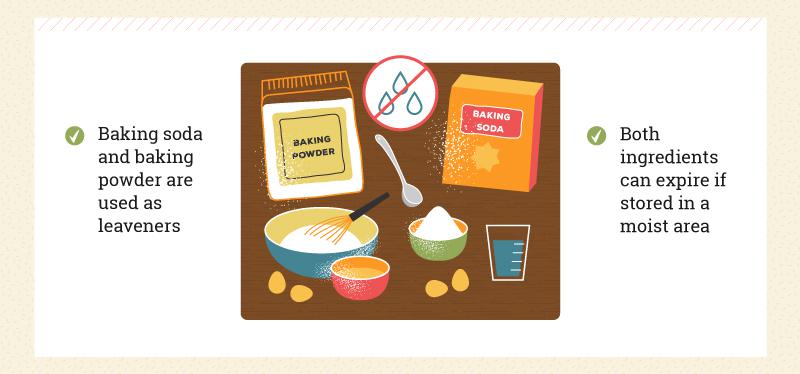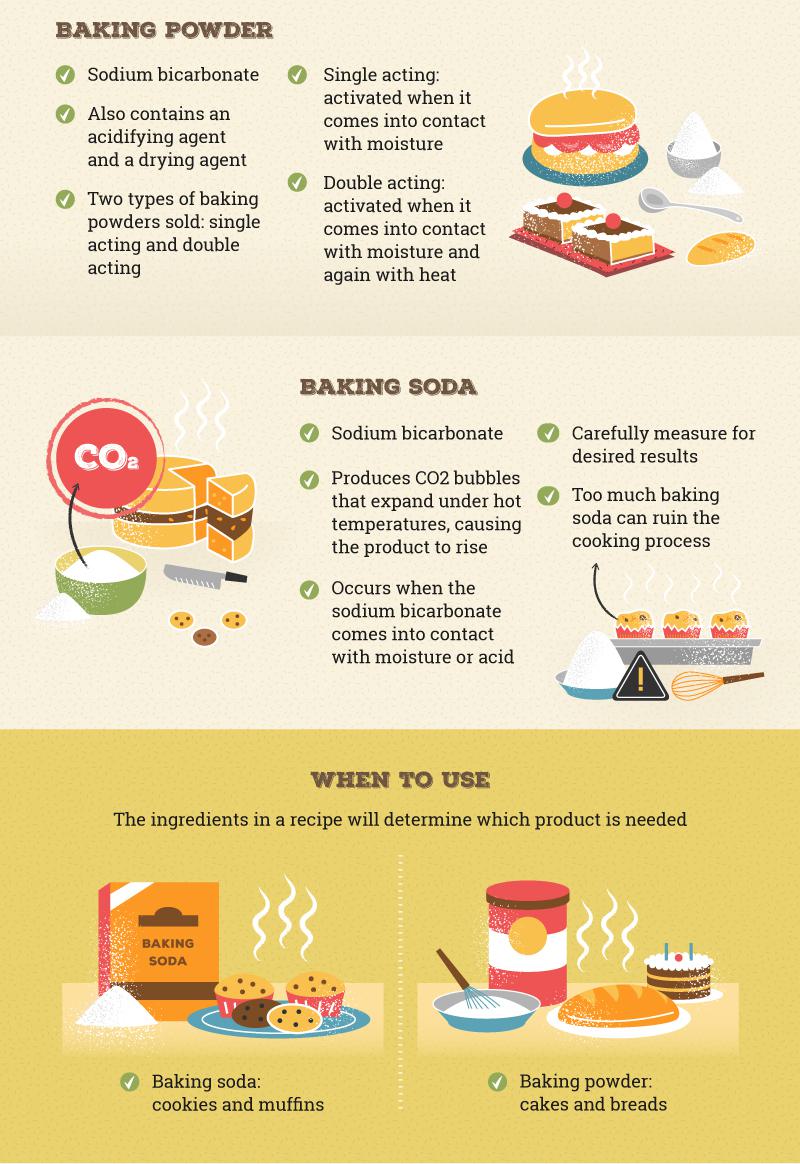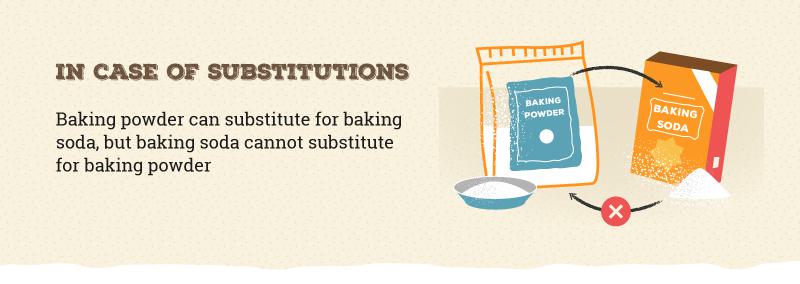Baking powder and baking soda are two of the most commonly used items in the kitchen. Almost every baked good calls for one or the other, however often it's extremely hard to tell them apart. Knowing the difference between baking soda vs baking powder is crucial when it comes to baking the perfect treat. And while they may seem similar, they are definitely not the same.
While baking soda and baking powder are both leaveners, the chemicals in them are completely different. This difference in chemicals plays a crucial role in the successful cooking of a baked good, and it's important to know why you're using the ingredient chosen. To effectively tell the two apart before we get into their similarities and differences, let's figure out what is in each leavening agent and what they're most commonly used for.
Are Baking Powder and Baking Soda the Same?
The short answer is no, baking powder and baking soda are not the same. They are used differently and their chemical reactions are different. Some recipes will use both to achieve the desired texture of baked goods. Whether you are making cake, cookies, muffins and even bread, make sure you follow the recipe and know the difference between baking soda and baking powder.

Baking Soda
Baking soda, aka sodium bicarbonate, is a commonly known food additive and baking ingredient. While there are many uses of baking soda, it is commonly found in recipes as a leavening agent to help baked goods rise. When chemically reactive, it produces carbon dioxide bubbles that expand under hot temperatures and cause baked goods to rise. This chemical reaction is triggered when baking soda comes in contact with moisture and an acidic ingredient like lemon juice, buttermilk, sour cream or a dry acid.
Because baking soda is used as a base, it must be mixed with an acid to produce the chemical reaction desired to create carbon dioxide gas. This desired effect is what baked goods need to expand, rise and bake properly.
Omitting baking soda in a baking recipe that calls for it will cause baked goods to fall flat and not cook properly. When using baking soda, it's important to note that it is a strong ingredient and the right amount must be added to the recipe to achieve the proper rise. The use of too much baking soda will result in a soapy taste.
Check out Bob's Red Mill Baking Soda for nutritional information about baking soda and recipe ideas!
Baking Powder
Much like baking soda, baking powder is also made of sodium bicarbonate. However, the thing that sets the two apart is that baking powder already contains both an acidifying agent and drying agent. These two components are usually made of cream of tartar (potassium bitartrate) and a starch. This means you can make your own baking powder out of baking soda and cream of tartar if you dont have baking powder in your pantry.

While baking powder already has more ingredients from the start, this does not mean that it's easier to use. In fact, sometimes it can be much more challenging. Most grocery stores sell two different types of baking powder. The first is single acting and the second is double acting. Because single-acting baking powder requires moisture to be activated, once it does come in contact with moisture the recipe must be baked immediately after mixing.
Double-acting powders, on the other hand, go through two different phases of activation. It enters the first phase of activation once a wet ingredient is added, and the second when heat is applied. Because of these two activation states, double-acting baking powder can sit for longer before baking.
While both single and double acting baking powder both have a drying agent and an acidic compound, double acting is the more popular option when it comes to homemade baked goods.

Check out Bobs Red Mill
Baking Powder for a quick double-acting baking powder free of aluminum and bitter aftertaste!
What Is the Difference Between Baking Soda vs. Baking Powder
The key difference between baking soda and baking powder is that baking soda is simply sodium bicarbonate while baking powder is sodium bicarbonate mixed with an acidifying agent and drying agent already. Where baking soda needs a liquid and an acid to become active, baking powder only needs the liquid. This is why they serve different purposes in the baking and cooking process. Depending on what youre making, the recipes might call for one or the other, or in many cases sometimes both.
When to Use Baking Soda vs. Baking Powder
Now that weve distinguished the differences between baking powder and baking soda, how do you know which
chemical leavening agent to use in your recipes? The goal of both ingredients is to produce a baked good with the desired lift and texture. The ingredients in the recipe determine which ingredient is needed to achieve this result.
Because of baking sodas bitter taste, it must be paired with a sweeter tasting
acidic compound. Baking soda is most commonly used in cookie and muffin recipes. Baking powder, however, already contains an acid and a base and has a more neutral taste, which works great when baking cakes and bread. In rare cases when recipes contain too many acidic ingredients, the recipe will call for both baking soda and baking powder to neutralize the batter or dough.

What Happens if You Use Baking Soda Instead of Baking Powder and Vice Versa?
Ultimately, baking is a science. Incorporating baking soda or baking powder is one part of the chemical reaction. If you change up one piece of the science, you have to make sure that its balanced out in other ways. Ultimately, not following a recipe by using baking soda instead of baking powder and vice versa could lead to a change in the texture and even taste of the food. Youre best off following the recipe, but in case you cant, here are some things that might help you.
Substituting Baking Soda and Baking Powder
So you're halfway through mixing a recipe when you realize it calls for baking soda but you only have baking powder. Can the two be substituted for one another? The quick answer is yes, but only in one circumstance. While baking powder can be
a baking soda substitute, baking soda cannot be used in place of baking powder because it does not contain the proper acidic ingredients to make the baked good rise.
Lastly, its important to remember that both baking soda and baking powder do expire and can be prematurely activated if you keep it in a moist environment. Its always important to check for freshness before using either one in a baked good!
Now that you know the difference between baking powder and baking soda, it's time to get in the kitchen. Whether you're baking cakes or bread, knowing how to use these chemical leavener ingredients will ensure positive baking results in all of your favorite recipes.
 Sources:
Sources:
- https://news.ncsu.edu/2014/05/baking-soda-powder/
- https://www.bonappetit.com/story/baking-powder-vs-baking-soda-difference
- https://www.thespruceeats.com/baking-soda-vs-baking-powder-995111




 While baking powder already has more ingredients from the start, this does not mean that it's easier to use. In fact, sometimes it can be much more challenging. Most grocery stores sell two different types of baking powder. The first is single acting and the second is double acting. Because single-acting baking powder requires moisture to be activated, once it does come in contact with moisture the recipe must be baked immediately after mixing.
Double-acting powders, on the other hand, go through two different phases of activation. It enters the first phase of activation once a wet ingredient is added, and the second when heat is applied. Because of these two activation states, double-acting baking powder can sit for longer before baking.
While both single and double acting baking powder both have a drying agent and an acidic compound, double acting is the more popular option when it comes to homemade baked goods.
While baking powder already has more ingredients from the start, this does not mean that it's easier to use. In fact, sometimes it can be much more challenging. Most grocery stores sell two different types of baking powder. The first is single acting and the second is double acting. Because single-acting baking powder requires moisture to be activated, once it does come in contact with moisture the recipe must be baked immediately after mixing.
Double-acting powders, on the other hand, go through two different phases of activation. It enters the first phase of activation once a wet ingredient is added, and the second when heat is applied. Because of these two activation states, double-acting baking powder can sit for longer before baking.
While both single and double acting baking powder both have a drying agent and an acidic compound, double acting is the more popular option when it comes to homemade baked goods.
 Check out Bobs Red Mill Baking Powder for a quick double-acting baking powder free of aluminum and bitter aftertaste!
Check out Bobs Red Mill Baking Powder for a quick double-acting baking powder free of aluminum and bitter aftertaste!

 Sources:
Sources: